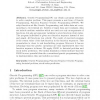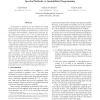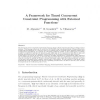1686 search results - page 79 / 338 » Programs as polygraphs: computability and complexity |
104
click to vote
ICIC
2009
Springer
15 years 6 months ago
2009
Springer
Genetic Programming(GP) can obtain a program structure to solve complex problem. This paper presents a new form of Genetic Programming, Function Sequence Genetic Programming (FSGP)...
CVPR
2007
IEEE
16 years 1 months ago
2007
IEEE
In this paper we introduce two new methods for solving binary quadratic problems. While spectral relaxation methods have been the workhorse subroutine for a wide variety of comput...
105
click to vote
ENTCS
2007
14 years 12 months ago
2007
The timed concurrent constraint programming language (tccp in short) was introduced for modeling reactive systems. This language allows one to model in a very intuitive way typica...
173
click to vote
ICLP
2009
Springer
16 years 16 days ago
2009
Springer
Recently, enabling modularity aspects in Answer Set Programming (ASP) has gained increasing interest to ease the composition of program parts to an overall program. In this paper, ...
EUROPAR
2003
Springer
15 years 5 months ago
2003
Springer
Parallel programming is seen as an effective technique to improve the performance of computationally-intensive programs. This is done at the cost of increasing the complexity of t...



